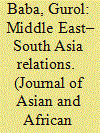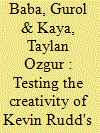| Srl | Item |
| 1 |
ID:
190896


|
|
|
|
|
| Summary/Abstract |
The Middle East and South Asia can be defined as interlinked political spaces that experience deepening interactions of their energetic and ambitious regional powers together with the constant strategic competition of major global powers. This vibrancy has been relentlessly fuelled by the geo-economic/political/strategic, and humanitarian needs of these two regions’ actors. Since there are no regional groupings effectively representing the two regions these interactions are mostly minilateral or bilateral and are bolstered by historical, cultural and religious affinities. Yet, due to the relatively higher power status of the Middle East, these transregional interactions operate on an asymmetrical basis.
|
|
|
|
|
|
|
|
|
|
|
|
|
|
|
|
| 2 |
ID:
190889


|
|
|
|
|
| Summary/Abstract |
The politico-economically uneven structure, fragile inter-state affairs and weak regionalism of the Middle East make it difficult to explain its interactions with South Asia within a single theoretical pattern. Neither interregionalism nor multilateralism could illuminate these interactions individually. This study merges recently popularized interaction schemes of minilateralism and bilateralism on a transregional basis to provide an eclectic and flexible conceptual framework to explain the patterns of Middle East–South Asia inter-state affairs. It argues that regardless of its weak regionalism and intra-regional power games, the Middle East, with these trendy interaction schemes, could still develop effective inter-state relations with South Asia. The study utilizes the empirical analysis method to interpret various levels and types of interactions between actors of various capabilities. In addition, it also uses case studies to produce a deeper context-dependent knowledge of Middle Eastern – South Asian actors.
|
|
|
|
|
|
|
|
|
|
|
|
|
|
|
|
| 3 |
ID:
138095


|
|
|
|
|
| Summary/Abstract |
The 2007 Australian Parliamentary Elections brought a new dynamic to Australia’s foreign policy: the Kevin Rudd factor. The Prime Minister sought to develop a more proactive and multi-faceted foreign policy around ‘Creative Middle Power Diplomacy’. This study aims to cast light on the dynamism in Australia’s Foreign Policy with Kevin Rudd within the framework of middle power activism. The research firstly focuses on the difficulties of defining and classifying middle powers through which it will put forward specific ‘commonalities’ for successful middle power foreign policy outcomes. The study of the EU–Australia Partnership Framework and the Asia-Pacific Community proposals – both of which were priorities for Kevin Rudd – reveal the potential and limits of middle power activism. This study argues that in today’s world, middle powers have growing potential to pursue specific foreign policy goals but their ability to achieve these goals is constrained by Great Powers’ interests and consent, and also by the nature or ‘commonalities’ of middle power diplomatic practice.
|
|
|
|
|
|
|
|
|
|
|
|
|
|
|
|